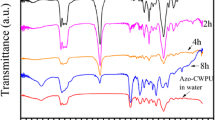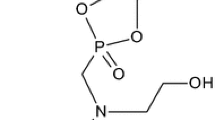Abstract
In this paper, we reported a series of green fluorescent flame-retardant waterborne polyurethane polyols. The polyurethane polyols were uniformly sized and possessed decent colloidal stability. Comparing to other reported products, our aqueous dispersions showed much stronger fluorescence intensity and greatly improved long-term stability, which were desired for practical applications. Small molecule conjugation units were gated into polyurethane chains via reaction between −OH of naphthalene and −NCO of diisocyanate, which restricts intramolecular rotation of naphthalene chromophores and non-radiative transition to enhance fluorescence intensity. The non-radiative transition and chromophore aggregation are weakened to hinder aggregation-caused quenching of chromophores to improve fluorescence by weak collision. This study has demonstrated a facile method to prepare waterborne polyurethane polyols, providing detailed explanation and guidance for related work in the future.








Similar content being viewed by others
Data availability
The authors declare that all data supporting the finding of this study are available within the paper and its supplementary information.
References
Alcón MJ, Ribera G, Galià M, Cádiz V (2005) Advanced flame-retardant epoxy resins from phosphorus-containing diol. J Polym Sci A Polym Chem 43:3510–3515. https://doi.org/10.1002/pola.20856
Chen S, Zhang S, Jin T, Zhao G (2016) Synthesis and characterization of novel covalently linked waterborne polyurethane/Fe3O4 nanocomposite films with superior magnetic, conductive properties and high latex storage stability. Chem Eng J 286:249–258. https://doi.org/10.1016/j.cej.2015.10.089
Chung YC, Choi JW, Lee HL, Chun BC (2014) The characterization and effects of the alizarin series dyes grafted to polyurethane copolymers on the photoluminescence and low temperature flexibility. Fibers Polym 15:8–17. https://doi.org/10.1007/s12221-014-0008-3
Chung YC, Yang K, Choi JW, Chun BC (2014) Characterisation and application of polyurethane copolymers grafted with photoluminescent dyes. Color Technol 130:305–313. https://doi.org/10.1111/cote.12097
Collong W, Göbel A, Kleuser B, Lenhard W, Sonntag M (2002) 2K waterborne clearcoat—a competition between crosslinking and side reactions. Prog Org Coat 45:205–209
Gong Y, Chen G, Peng Q, Yuan WZ, Xie Y, Li S, Zhang Y, Tang BZ (2015) Achieving persistent room temperature phosphorescence and remarkable mechanochromism from pure organic luminogens. Adv Mater 27:6195–6201. https://doi.org/10.1002/adma.201502442
Han SL, Hsu SL (1989) An analysis of phase separation kinetics of model polyurethanes. Macromolecules 22:1100–1105
Hu X, Ding Y, Liu J, Deng Y, Cheng C (2016) Synthesis and fluorescence properties of a waterborne polyurethane–acrylic hybrid polymeric dye. Polym Bull 74:555–569. https://doi.org/10.1007/s00289-016-1729-9
Hu X, Zhang X, Liu J, Dai J (2014) Synthesis, characterization and fluorescence performance of a waterborne polyurethane-based fluorescent dye 4-amino-N-cyclohexyl-1,8-naphthalimide, WPU-ACN. Polym Int 63:453–458. https://doi.org/10.1002/pi.4523
Hu X, Zhang X, Liu J et al (2013) Synthesis, characterization and fluorescence performance of a waterborne polyurethane-based polymeric dye. J Lumin 42:23–27. https://doi.org/10.1016/j.jlumin.2013.02.048
Hu XH, Zhang XY, Dai JB (2011) Synthesis and characterization of a novel waterborne stilbene-based polyurethane fluorescent brightener. Chin Chem Lett 22:997–1000. https://doi.org/10.1016/j.cclet.2011.01.028
Huang H, Qiu Z, Han T, Kwok RTK, Lam JWY, Tang BZ (2017) Synthesis of functional poly(propargyl imine) s by multicomponent polymerizations of bromoarenes, isonitriles, and alkynes. ACS Macro Lett 6:1352–1356. https://doi.org/10.1021/acsmacrolett.7b00872
Inamdar AI, Cho S, Jo Y, Kim J, Han J, Pawar SM, Woo H, Kalubarme RS, Park CJ, Kim H, Im H (2016) Optical properties in Mn-doped ZnS thin films: photoluminescence quenching. Mater Lett 163:126–129. https://doi.org/10.1016/j.matlet.2015.10.074
Jana Machotova LZ, Bacovska R, Vrastil J, Hudakova M, Snuparek J (2016) Self-crosslinking acrylic latexes with copolymerized flame retardant based on halogenophosphazene derivative. Prog Org Coat 101:322–330. https://doi.org/10.1016/j.porgcoat.2016.09.007
Kim BK, Lee JC (1996) Polyurethane ionomer dispersions from poly(neopertylene phthalate) glycol and isophorone diisocyanate. Polymer 31:469–475
Lei L, Zhong L, Lin X, Li Y, Xia Z (2014) Synthesis and characterization of waterborne polyurethane dispersions with different chain extenders for potential application in waterborne ink. Chem Eng J 253:518–525. https://doi.org/10.1016/j.cej.2014.05.044
Li M, Qiang X, Xu W, Zhang H (2015) Synthesis, characterization and application of AFC-based waterborne polyurethane. Prog Org Coat 84:35–41. https://doi.org/10.1016/j.porgcoat.2015.02.009
Mao H, Wang Y, Yao D, Wang C, Sun S (2016) Synthesis of blocked waterborne polyurethane polymeric dyes with tailored molecular weight: thermal, rheological and printing properties. RSC Adv 6:56831–56838. https://doi.org/10.1039/c6ra14344j
Poussard L, Lazko J, Mariage J, Raquez JM, Dubois P (2016) Biobased waterborne polyurethanes for coating applications: how fully biobased polyols may improve the coating properties. Prog Org Coat 97:175–183. https://doi.org/10.1016/j.porgcoat.2016.04.003
Qin W, Yang Z, Jiang Y, Lam JWY, Liang G, Kwok HS, Tang BZ (2015) Construction of efficient deep blue aggregation-induced emission luminogen from triphenylethene for nondoped organic light-emitting diodes. Chem Mater 27:3892–3901. https://doi.org/10.1021/acs.chemmater.5b00568
Si H, Liu H, Shang S, Song J, Liao S, Wang D, Song Z (2016) Preparation and properties of maleopimaric acid-based polyester polyol dispersion for two-component waterborne polyurethane coating. Prog Org Coat 90:309–316. https://doi.org/10.1016/j.porgcoat.2015.11.003
Wan W, Wang H, Lin H, Wang J, Jiang Y, Jiang H, Zhu S, Wang Z, Hao J (2015) Synthesis, electrochemical, photophysical, and electroluminescent properties of organic dyes containing pyrazolo[3, 4-b]quinoline chromophore. Dyes Pigments 121:138–146. https://doi.org/10.1016/j.dyepig.2015.05.002
Wang Q, Mu B, Zhang Y, Zhang J, Wang A (2016) Palygorskite-based hybrid fluorescent pigment: preparation, spectroscopic characterization and environmental stability. Microporous Mesoporous Mater 224:107–115. https://doi.org/10.1016/j.micromeso.2015.11.034
Wu G, Li J, Chai C, Ge Z, Lin J, Luo Y (2015) Synthesis and characterization of novel post-chain extension flame retardant waterborne polyurethane. RSC Adv 5:97710–97719. https://doi.org/10.1039/c5ra12975c
Wu G, Li J, Luo Y (2016) Flame retardancy and thermal degradation mechanism of a novel post-chain extension flame retardant waterborne polyurethane. Polym Degrad Stab 123:36–46. https://doi.org/10.1016/j.polymdegradstab.2015.11.004
Yin X, Li X, Luo Y (2017) Synthesis and characterization of multifunctional two-component waterborne polyurethane coatings: fluorescence, thermostability and flame retardancy. Polymers 9:492–506. https://doi.org/10.3390/polym9100492
Yuan WZ, Tan Y, Gong Y, Lu P, Lam JWY, Shen XY, Feng C, Sung HHY, Lu Y, Williams ID, Sun JZ, Zhang Y, Tang BZ (2013) Synergy between twisted conformation and effective intermolecular interactions: strategy for efficient mechanochromic luminogens with high contrast. Adv Mater 25:2837–2843. https://doi.org/10.1002/adma.201205043
Yuan Y, Yang H, Yu B, Shi Y, Wang W, Song L, Hu Y, Zhang Y (2016) Phosphorus and nitrogen-containing polyols: synergistic effect on the thermal property and flame retardancy of rigid polyurethane foam composites. Ind Eng Chem Res 55:10813–10822. https://doi.org/10.1021/acs.iecr.6b02942
Zhang Y, Shen P, He B, Luo W, Zhao Z, Tang BZ (2018) New fluorescent through-space conjugated polymers: synthesis, optical properties and explosive detection. Polym Chem 9:558–564. https://doi.org/10.1039/c7py01700f
Zhou C, Xie T, Zhou R, Trindle CO, Tikman Y, Zhang X, Zhang G (2015) Waterborne polyurethanes with tunable fluorescence and room-temperature phosphorescence. ACS Appl Mater Interfaces 7:17209–17216. https://doi.org/10.1021/acsami.5b04075
Acknowledgments
This work is funded by the National Natural Science Foundation of China under grant no. 51605247 and the National Key Research and Development Program of China under grant no. 2016YFC0204400.
Author information
Authors and Affiliations
Contributions
Y.L. conceived the idea and designed the experiments. X.Y. and Y. L. synthesized the samples and performed all the experiments and data analysis. All authors contributed to the writing of the manuscript.
Corresponding author
Ethics declarations
Conflict of interest
The authors declare that they have no conflict of interest.
Additional information
Publisher’s note
Springer Nature remains neutral with regard to jurisdictional claims in published maps and institutional affiliations.
Supplementary information
ESM 1
(PDF 156 kb)
Rights and permissions
About this article
Cite this article
Yin, X., Luo, Y. Green fluorescent waterborne polyurethane polyols. Colloid Polym Sci 299, 845–853 (2021). https://doi.org/10.1007/s00396-021-04807-8
Received:
Revised:
Accepted:
Published:
Issue Date:
DOI: https://doi.org/10.1007/s00396-021-04807-8




